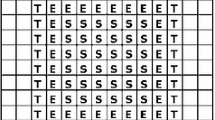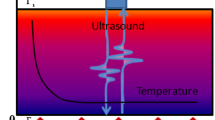Abstract
In this paper, solution of inverse problems in heat conduction transient fields is investigated. For this purpose, a new time-domain version of linear sampling method (TDLSM) is developed for cavity detection in a heat conductor. The linear sampling method (LSM) is an effective approach to image the geometrical features of unknown targets. Although this method has been used in the context of inverse scattering problems such as solid, acoustics, and electromagnetism, there is no specific attempt to apply this method to identification of cavities in heat conductors. This study emphasizes the implementation of the LSM in the time-domain fields using finite element method. A set of numerical simulations on two-dimensional transient heat conduction problems is presented to highlight many effective features of the proposed TDLSM fast qualitative identification method.













Similar content being viewed by others
Abbreviations
- ‖ ‖:
-
Norm’s vector
- *:
-
Convolution operator
- c p :
-
Specific heat
- d :
-
Number of spatial dimensions
- D:
-
Domain of the cavity
- ∂D :
-
Boundary of the cavity
- g :
-
Density distribution
- H():
-
Heaviside function
- k :
-
Thermal conductivity
- L 2 :
-
Hilbert space
- N d :
-
Neumann-to-Dirichlet operator
- N t :
-
Number of time steps
- N r :
-
Number of receivers
- N S :
-
Number of transmitters
- n :
-
Outward unit normal vector
- \(\bar{q}(\varvec{x},t)\) :
-
Prescribed inflow heat flux
- r :
-
Distance
- S :
-
External surface
- S 1 :
-
Excitation surface
- S 2 :
-
Observation surface
- \(SL_{{S_{1} }}\) :
-
Single layer heat potential operator
- t :
-
Time(s)
- \(\bar{T}(\varvec{x},t)\) :
-
Prescribed temperature
- \(T^{D} (\varvec{x},t)\) :
-
Total temperature field
- \(T^{S} (\varvec{x},t)\) :
-
Differential temperature field
- \(\widehat{T}\) :
-
Fundamental solution of the diffusion equation
- U :
-
Left-singular vectors
- \({v}(\varvec{x},t)\) :
-
Superposition temperature
- V :
-
Right-singular vectors
- \(w^{{S}} (\varvec{x},t)\) :
-
Superposition of differential temperature field
- \(\varvec{x} = \left[ {x_{1} ,x_{2} } \right]^{T}\) :
-
Cartesian coordinates
- z :
-
Sampling point
- \(\phi_{\varvec{z}} (\varvec{x},t)\) :
-
Radiated temperature vector
- ρ :
-
Mass density
- Ω:
-
Homogeneous media
- ∇.(∇):
-
Laplace operator
- δ :
-
Dirac delta function
- \(\mathcal{L}\) :
-
Partial differential operator
- τ :
-
Time
- λ :
-
Tikhonov regularization parameter
- ε :
-
Error
- σ :
-
Singular value
- D :
-
Dirichlet boundary condition
- N :
-
Neumann boundary condition
- n, m :
-
Time index
- i, j :
-
Spatial index
- FEM:
-
Finite element method
- LSM:
-
Linear sampling method
- MFS:
-
Method of fundamental solution
- SVD:
-
Singular value decomposition
- TDLSM:
-
Time domain linear sampling method
References
Tanaka M, Masuda Y (1986) Boundary element method applied to some inverse problems. Eng Anal 3(3):138–143
Le Niliot C, Lefevre F (2001) A method for multiple steady line heat sources identification in a diffusive system: application to an experimental 2D problem. Int J Heat Mass Transfer 44:1425–1438
Niliot CL, Lefevre F (2004) A parameter estimation approach to solve the inverse problem of point heat sources identification. Int J Heat Mass Transfer 47(4):827–841
Karami G, Hematiyan MR (2000) A boundary element method of inverse non-linear heat conduction analysis with point and line heat sources. Commun Numer Methods Eng 16:191–203
Huang CH, Ozisik MN (1992) Inverse problem of determining the unknown strength of an internal plane heat source. J Franklin Instit 329:751–764
Neto AJS, Ozisik MN (1993) Simultaneous estimation of location and timewise varying strength of a plane heat source. Numer Heat Transfer Appl 24:467–477
Neto AJS, Ozisik MN (1992) Two-dimensional inverse heat conduction problem of estimating the time-varying strength of a line heat source. J Appl Phys 71:5357–5362
Wang SK, Lee HL, Yang YC (2009) Inverse problem of estimating time-dependent heat generation in a frictional heated strip and foundation. Int Commun Heat Mass Transfer 36(9):925–930
Kołodziej JA, Mierzwiczak M, Ciałkowski M (2010) Application of the method of fundamental solutions and radial basis functions for inverse heat source problem in case of steady-state. Int Commun Heat Mass Transfer 37(2):121–124
Johansson BT, Lesnic D, Reeve T (2012) A method of fundamental solutions for the radially symmetric inverse heat conduction problem. Int Commun Heat Mass Transfer 39(7):887–895
Jin LMB (2007) The method of fundamental solutions for inverse source problems associated with the steady-state heat conduction. Int J Numer Methods Eng 69:1570–1589
Bakushinsky AB, Kokurin MY (2005) Iterative methods for approximate solution of inverse problems, 1st edn. Springer, Berlin
Colton D, Kress R (1998) Inverse acoustic and electromagnetic scattering theory, 2nd edn. Springer, Berlin
Bleistein N (1984) Mathematical methods for wave phenomena, 1st edn. Academic Press, New York
Zapalowski L, Fiddy MA, Leeman S (1984) On inverse scattering in the first Born approximation. In IEEE 1984 ultrasonics symposium, Dallas, Texas, USA, pp 827–830
Cakoni F, Colton D (2006) Qualitative methods in inverse scattering theory. Springer, Berlin
Cakoni F, Colton D, Monk P (2011) The linear sampling method in inverse electromagnetic scattering. SIAM, Philadelphia
Colton D, Coyle J, Monk P (2000) Recent developments in inverse acoustic scattering theory. SIAM Rev 42(3):369–414
Bonnet M, Guzina BB (2004) Sounding of finite solid bodies by way of topological derivative. Int J Numer Methods Eng 61(13):2344–2373
Guzina BB, Bonnet M (2004) Topological derivative for the inverse scattering of elastic waves. Q J Mech Appl Math 57(2):161–179
Kirsch A (2002) The MUSIC-algorithm and the factorization method in inverse scattering theory for inhomogeneous media. Inverse Probl 18(4):1025–1040
Potthast R (2006) A survey on sampling and probe methods for inverse problems. Inverse Probl 22(2):1–47
Potthast R (2001) Point sources and multipoles in inverse scattering theory, 1st edn. Taylor & Francis Group, NewYork
Carslaw HS, Jaeger JC (1959) Conduction of heat in solids, 2nd edn. Clarendon Press, Oxford
Morse PM, Feshbach H (1953) Methods of theoretical physics. McGraw-Hill, New York
Zienkiewicz OC, Taylor RL (2000) The finite element method, 5th edn. Butterworth and Heinmann, Oxford, UK
Hadamard J (1923) Lectures on the Cauchy problem in linear partial differential equations. Yale University Press, New Haven
Kirsch A (2011) An introduction to the mathematical theory of inverse problems. Springer, New York
Author information
Authors and Affiliations
Corresponding author
Rights and permissions
About this article
Cite this article
Dehghan Manshadi, S.H., Khaji, N. Cavity detection in a heat conductor using linear sampling method. Heat Mass Transfer 50, 973–984 (2014). https://doi.org/10.1007/s00231-014-1309-1
Received:
Accepted:
Published:
Issue Date:
DOI: https://doi.org/10.1007/s00231-014-1309-1




